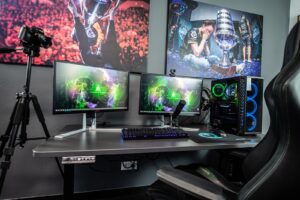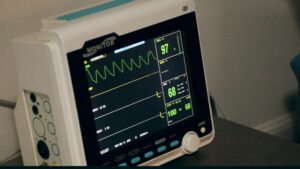Gaming takes many different forms these days, from simple puzzle games on your phone to more immersive and graphically complex experiences on a console or PC. So which monitor should you get to play the latest AAA game?
In this article, we will be looking at some key factors to consider when choosing a gaming monitor, including size, resolution, response time, refresh rate, and input lag. We will also provide our recommendations for the best monitors for gaming in 2019!
What is the Difference between Monitors and Displays?
When it comes to choosing the right monitor for gaming, the size of the display is a critical factor. Monitors are usually measured in inches and displays are measured in pixels. Here’s a breakdown of what each measure:
Monitors: A monitor is typically around 27 inches wide and 17 inches high. They come in different sizes, but a good rule of thumb is to buy one that is twice as wide as you are tall.
Displays: Displays are typically around 24 inches wide and 30 inches high. They come in different sizes, but a good rule of thumb is to buy one that is three times as wide as you are tall.
What to Look for in a Gaming Monitor
When it comes to choosing the perfect gaming monitor, there are a few things you should consider. First and foremost, you need to decide what type of gaming you’re into. Is it first-person shooters (FPS)? MOBA? Role-playing games (RPG)? If so, you’ll want to pick a monitor that matches your style of play.
Next, you need to decide how big a screen size you need. Do you want a large monitor for playing FPS games or do you want something more portable for RPG games? And finally, what price range are you willing to spend? There are monitors available in all price ranges, so it’s important to find one that fits your budget.
Below are just a few of the things to look for when choosing a gaming monitor:
Screen size: The most important factor when choosing a gaming monitor is the size of the screen. Make sure the size is big enough for your needs. You may want something small for mobile games or something bigger for console games.
The most important factor when choosing a gaming monitor is the size of the screen. Make sure the size is big enough for your needs. You may want something small
Best Practices for Setting Up a Gaming Monitor
There is no definitive answer when it comes to choosing the “best” gaming monitor, as the size, resolution, and features that are important to you will vary depending on your individual needs. However, there are a few general guidelines that can help you make a more informed decision.
First, it is important to decide what size gaming monitor is best for you. Most monitors range in size from 24 inches to 31 inches diagonal, but there are also options available in larger sizes (34-inch and larger). It is also important to consider how much space you have available on your desktop or gaming rig. If you only have a small amount of desktop space, then a smaller monitor may be better for you. On the other hand, if you have more desktop space available, then a larger monitor may be better for gaming.
Second, it is important to decide what kind of resolution you want for your gaming monitor. Monitors typically come with a range of resolutions from 1920×1080 all the way up to 4K Ultra HD (3840×2160). The higher the resolution, the sharper the image will appear and the slower your computer will run. However, if you are mainly
How to Choose the Right Size for Your Needs
There is no single answer to this question as everyone’s needs and preferences will vary. However, here are a few general tips to help you choose the right size monitor for your needs:
– Do some research on what resolutions are available and what specs are required to play the games you want to play. Many games now come with higher resolution graphics that require a larger monitor or screen.
– Consider your location and whether you need a large monitor for viewing extended documents or graphics or if you just want an easy way to keep up with your online gaming.
– Consider how much desk space you have and whether you’ll be using the monitor primarily for work or entertainment purposes. A large monitor may not be necessary if all you plan on doing is reading email or browsing the internet. On the other hand, if you want to game or watch movies, a larger monitor will give you more space to do so without taking up too much room on your desk.
– Finally, take into account your budget and what features are important to you. Some monitors include features like VA (Vertical Alignment) panels that can improve image quality over cheaper TN (Twisted Nematic) panels. Some monitors also have built-in speakers and
Conclusion
When it comes to gaming, there are a lot of factors to consider. Obviously, the resolution of the monitor is one of the most important – if you want to be able to see all the fine details in your games, you’ll need a monitor with a high resolution. But what about the size? Do you need a large monitor for multiple screens or can you get by with a smaller model? And what about the brand? Some brands are known for their quality monitors while others may not be as well-known but offer just as good a product. So which size monitor is best for you? The answer may vary depending on your specific needs and preferences, so it’s important that you take some time to think about it before making any decisions.









